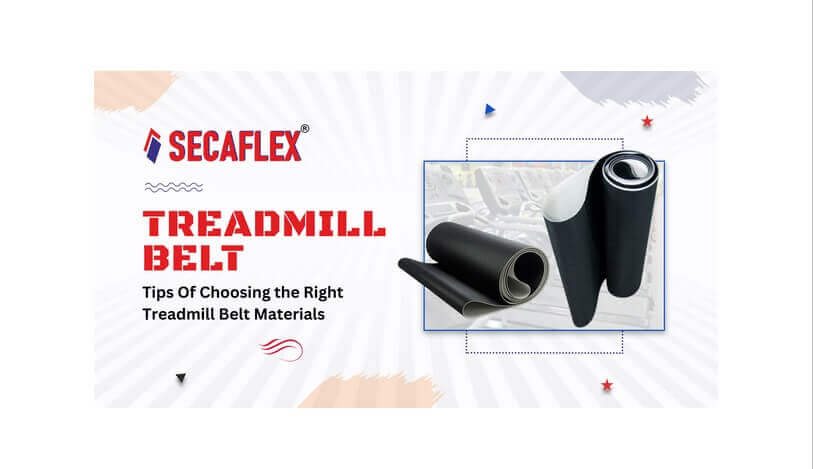If you’re in the market for a treadmill, you may have already come across the term “Treadmill Belt.” But what exactly is a belt, and why is it important to choose the right one?
A belt, or a running deck or surface, is part of the treadmill you run or walk on. It’s where your feet make contact with the treadmill and is responsible for supporting your body weight, absorbing impact, and providing a smooth surface for your workout. A treadmill belt, also known as a running belt or conveyor belt, is a key component of a treadmill machine. It is the surface on which users walk, jog, or run while using the treadmill for exercise or fitness purposes. Treadmill belts are typically made of durable materials, such as rubber, PVC, or silicone, and are designed to withstand regular wear and tear from continuous foot strikes and friction with the treadmill deck.
The quality of the belt can greatly affect your overall treadmill experience, including comfort, safety, and durability.
Materials Used in Treadmill Belts
The belts are typically made of one or more layers of materials designed to provide durability, flexibility and traction. The most common materials used in belts are:
- PVC (Polyvinyl Chloride): PVC is a synthetic plastic material commonly used in belts. It is known for its durability, water resistance, and affordability. PVC belts are typically made with multiple layers for strength and stability.
- Urethane: Urethane is a type of thermoplastic elastomer known for its exceptional durability, flexibility, and resistance to wear and tear. Urethane belts are highly resilient and can withstand heavy use, making them ideal for commercial gyms and high-intensity workouts.
- Polyester: Polyester is a synthetic fabric commonly used in belts. It is known for its strength, flexibility, and resistance to stretching. Polyester Rubber Timing Belt are typically made with multiple layers and coated with PVC or urethane for added durability.
- Hybrid: Some belts are made with a combination of materials, such as PVC and urethane, to balance durability, flexibility, and affordability. Hybrid treadmill belts may have different layers of materials, with each layer serving a specific purpose, such as providing traction or reducing noise.
- Thickness Options of Belts: The Thickness of a belt refers to the depth or height of the belt. Thicker belts are generally considered more durable and stable, while thinner belts are often more affordable and lighter. The Thickness of a belt offered by Treadmill Belt Manufacturers in India, can affect various factors, such as the cushioning, noise level, and overall feel of your workout. Here are the common thickness options for belts:
- Standard Thickness (1.6 – 2.0 mm): Standard-thickness belts are typically made of PVC or polyester materials and are commonly used in home treadmills. They balance affordability and durability well, making them suitable for moderate use and walking or jogging workouts.
- Thick Thickness (2.2 – 3.0 mm): Thick-thickness belts are usually made of PVC or urethane materials and are known for their durability and stability. They are commonly used in commercial and heavy-duty home treadmills, as they can withstand intense workouts and heavy usage.
- Ultra-Thick Thickness (3.2 – 4.0 mm): Ultra-thick belts are made of high-quality materials, such as urethane, and are known for their exceptional durability and cushioning. They are typically used in high-end commercial treadmills and are ideal for professional athletes or users who require maximum cushioning and stability.
- Durability Factors of Belts: Durability is a crucial factor to consider when choosing a belt, as it can affect the lifespan and performance of your treadmill.
Here are some key durability factors to keep in mind when selecting a belt.
- Weight Capacity: The weight capacity of a belt refers to the maximum amount of weight it can safely support. Choosing a belt with a weight capacity that exceeds your body weight is important to ensure that it can withstand the impact of your workouts without wearing out or breaking prematurely.
- Wear and Tear Resistance: Treadmill belts are subjected to constant friction and impact from your feet, which can cause wear and tear over time. Look for belts designed to be wear-resistant, meaning they can withstand the repetitive motion of running or walking without showing signs of excessive wear or fraying.
- Traction: Traction is an important factor in ensuring a safe and comfortable workout on a treadmill. A belt with good traction prevents slips and falls, providing stability and reducing the risk of accidents. Look for belts with a textured surface or a rubberized coating to enhance traction and grip.
- Maintenance Requirements: The durability of a belt can also be influenced by its maintenance requirements. Some belts may require regular lubrication or cleaning to keep them in optimal condition. Consider the maintenance requirements of the belt you are considering and choose one that fits your lifestyle and maintenance routine.
- Noise Reduction: A belt’s noise level can affect your workout’s overall experience. Look for belts that reduce noise, such as those with a cushioning layer or a sound-absorbing coating. A quieter belt can make your workouts more enjoyable and reduce disturbances to others around you.
- Brand Reputation: The reputation of the belt manufacturer can also be an indicator of its durability. Look for belts from reputable brands known for their quality and durability. Read customer reviews and check for certifications or awards that indicate the reliability and durability of the belt.
Conclusion
Choosing the right belt ensures a comfortable, safe, and durable workout experience.
Investing in a durable belt may cost more upfront, but it can save you money in the long run by reducing the need for frequent replacements and repairs. A high-quality belt can also provide a better workout experience, with improved cushioning, stability, and traction, leading to better performance and reduced risk of injuries. When it comes to looking for the right Treadmill Belt Suppliers in India, then DKT Engineering Enterprises is the best option.


